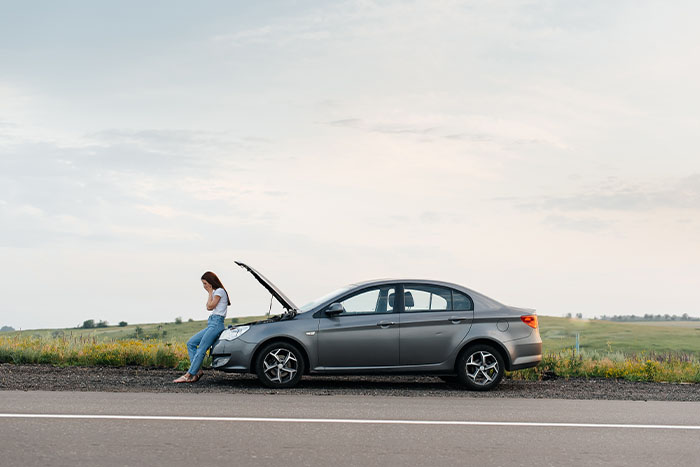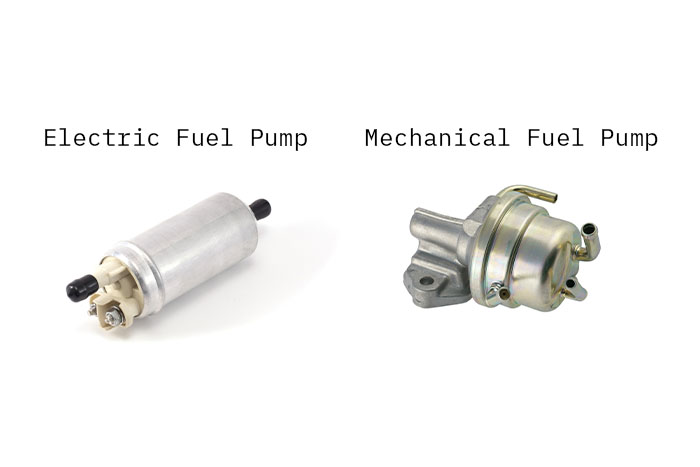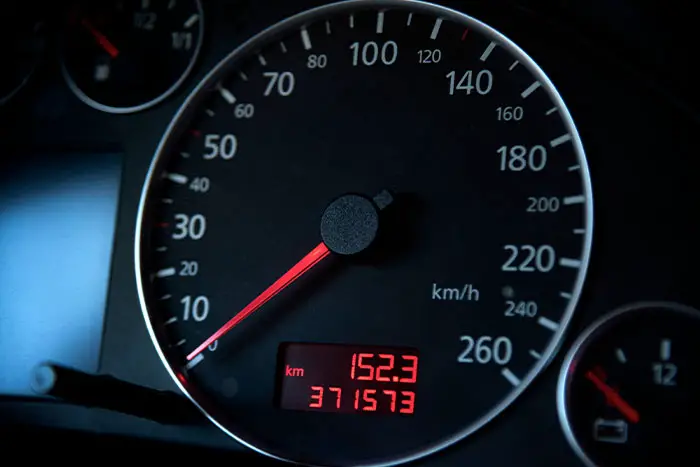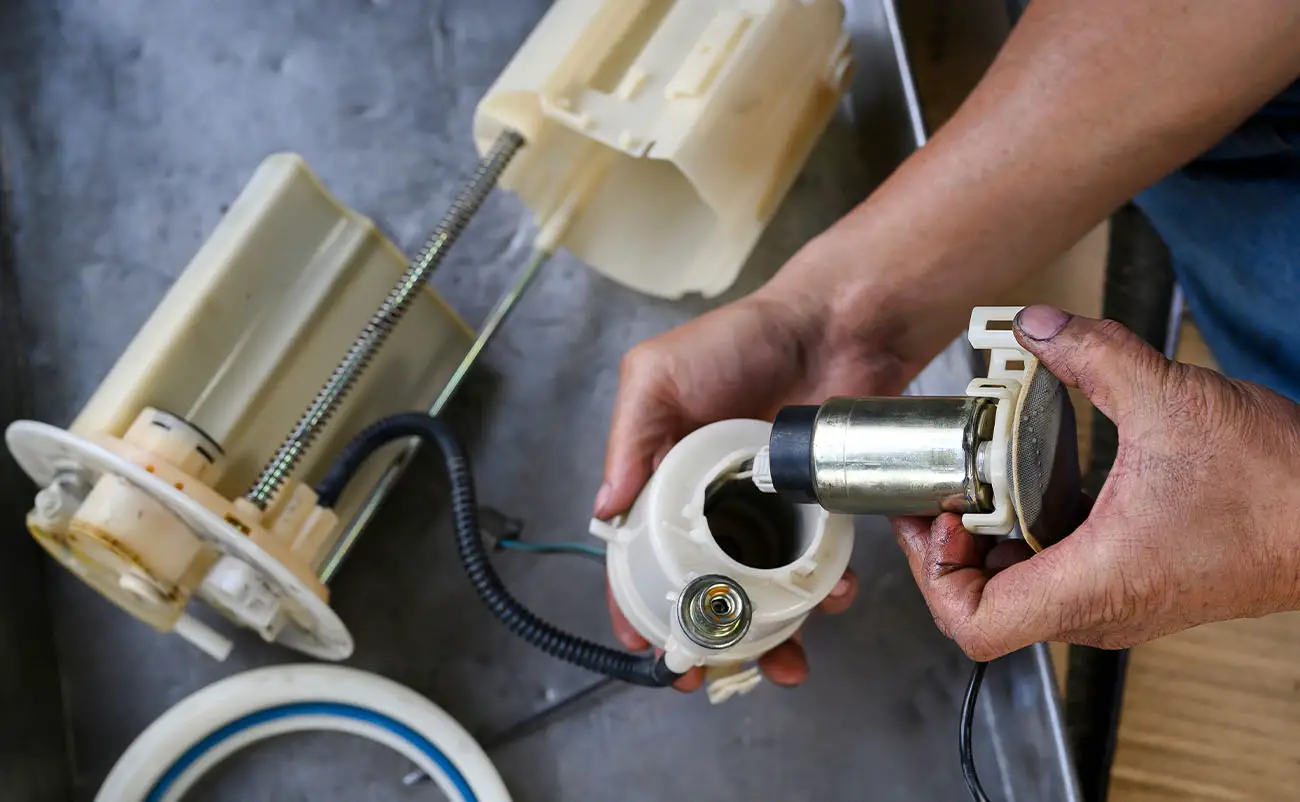You probably already know that your car will not run if it doesn’t have enough fuel. Your fuel pump is responsible for getting fuel from your gas tank to the engine. A faulty fuel pump can quickly leave you stranded, as your vehicle will not start or run once the fuel pump fails. So, will you get any warning before the fuel pump stops working?
There are some signs you can watch for that might signal a failing fuel pump. If you notice any of these signs, you should head to an auto repair shop soon to get the issue corrected. Here are the most common signs of a bad fuel pump, along with how much a replacement is going to cost you.
Table of Contents
Symptoms Of A Bad Fuel Pump

So, how can you tell when your fuel pump is going bad? There are several warning signs that you can watch for that might signal a faulty fuel pump. If you notice any of these symptoms, you should have a mechanic check your fuel pump right away. Here is what to watch for.
— Difficulty Starting
Hard starts are a very common sign of a bad fuel pump, especially hard cold starts. After your vehicle has been sitting for a while, the fuel pump must deliver a high amount of fuel to the engine to get it started. This can strain your vehicle’s fuel pump, and a weak fuel pump might not be able to deliver fuel quickly enough to start the car like normal. You might notice that your engine cranks longer than usual before finally starting up and running. If your vehicle has difficulty starting, you should address the issue before getting stranded.
— Engine Stalling
When your car is running correctly, the engine should not stop until you turn off the car. However, a stalled engine could be related to fuel system problems. When your fuel pump starts to die, it might begin to operate sporadically. This means that it may work fine at one moment and not work the next. When it stops working, your engine will stall because it is not getting enough fuel in the combustion chamber. Sudden engine stalling is not normal, and it can create a dangerous driving situation for yourself and others on the road. If your vehicle stalls without warning or explanation, you should get your car to an auto repair shop right away to diagnose the problem.
— Low Fuel Pressure
Low fuel pressure is almost always a sign of a bad fuel pump, although it can sometimes signal a bad fuel pressure regulator. Nearly all modern vehicles are equipped with electric fuel pumps. As the electric motor starts to fail, it can lose power before totally failing. This loss of power typically results in low fuel pressure as the pump can no longer push the fuel through the system with enough force. Since most vehicles are not equipped with a fuel pressure gauge, you might need a mechanic to diagnose this problem. You might only notice a loss of power or slow acceleration due to low pressure, but a mechanic can attach a gauge to your fuel rail to measure the pressure. If the pressure is below the manufacturer’s specifications, this is a weak fuel pump symptom you should not ignore.
— Engine Sputtering
Similar to engine stalling, a bad fuel pump can also cause engine sputtering. Even though your engine might not totally shut off, a lack of fuel can cause sputtering. Sputtering could also be the result of clogged fuel injectors or a sign of a bad fuel filter, but the fuel pump is a likely culprit. A fuel pump problem causes your car’s engine to sputter because it does not receive a constant fuel supply. This problem might be especially apparent under heavy loads or at high speeds when your engine needs a lot of fuel. If your engine is sputtering instead of running normally, you should investigate the cause of the problem.
— Poor Gas Mileage
Most people tend to think that a bad fuel pump never delivers enough fuel, but that is not always the case. Sometimes, a bad fuel pump can push too much fuel into the combustion chamber. In that case, you might notice symptoms that you would not ordinarily expect. One of those symptoms is poor fuel economy. If you notice that your vehicle is suddenly using more gas than normal, it could be related to a car fuel pump problem. So, if your fuel level is dropping more quickly than it should, it might be time to start the troubleshooting process to determine the cause. You might end up wasting money at the gas pump if you put off repairing your fuel pump.
— Engine Misfires
A lot of different problems can cause engine misfires, from bad spark plugs to contaminants in your gasoline. However, a bad fuel pump can also be responsible for a misfiring engine. If the misfires are bad enough, you might feel them — especially as you accelerate. Otherwise, you might notice your check engine light due to the misfires. When the misfire is related to a fuel pump problem, the fuel pump usually does not deliver enough fuel to the combustion chamber. This prevents the cylinder from firing properly, and it can lead to poor performance of your engine if it gets bad enough.
— Loss Of Power
Fuel pump failure can cause a loss of power in your engine, even though the engine might not stall. Under heavy load, the fuel pump needs to deliver a high volume of fuel to the engine. As the fuel pump starts to deteriorate, it cannot pump enough fuel to the engine. This creates a loss of power, and you will likely notice that your car does not accelerate as quickly as it should. If you find yourself pressing the gas pedal harder to get your vehicle to accelerate, you might have a fuel pump problem that needs to be addressed.
— Whining Noise
A loud whining noise coming from your fuel tank is almost always a surefire sign of a bad fuel pump. Today’s electric fuel pumps are equipped with a small DC motor that pumps fuel from the tank to the engine. Most fuel pumps make a quiet humming sound, and you can sometimes hear them at idle or when turning on the ignition. However, a loud whining sound is not normal. If you hear a whine from the fuel tank when you turn the key, your fuel pump is probably about to fail. You should get it checked out right away so that you can get the problem corrected before it fails.
— Engine Overheating
Most people don’t realize that fuel pump issues can cause your engine to overheat. The inadequate fuel delivery can cause your engine to work harder than it needs to. When the engine works too hard, it can overheat. Take a look at your coolant levels to see if they are normal. If you are not low on coolant, but your engine is overheating, you might have an issue with your fuel pump.
— Rough Idling
A rough idle can be the result of several issues, and a bad fuel pump is one of them. Insufficient fuel, low fuel pressure, or sporadic fuel delivery will lead to a rough idle, and all of these problems are usually caused by a faulty fuel pump. You might notice your tachometer bouncing at idle or even feel your car shaking as it idles. If you notice any of these things, you likely want to perform some diagnosis on the issue. You might find that you have dirty fuel injectors or another problem, but you might also need a fuel pump replacement. Either way, you should repair the issue so that your vehicle idles smoothly again.
— Check Engine Light
Since a check engine light can be caused by so many different things, you will want to have a repair shop read the trouble codes from the vehicle’s computer. These codes will give you more information about the cause of the light, and they might point to a problem with the fuel system. In that case, the fuel pump might start to fail. If it is, you will want to have it replaced before you get stranded on the road and are unable to restart your vehicle.
Types Of Fuel Pumps

There are two main types of fuel pumps, and the way that they operate is completely different. The time and effort required to replace a fuel pump are also related to the type of pump on your vehicle. Here are the two types and how they work.
— Electric Fuel Pump
Nearly all modern cars are equipped with electric fuel pumps. These pumps use a small DC motor to pump fuel from the fuel tank to the engine through the fuel lines. An electric fuel pump usually sits inside the gas tank, and it is submerged in gasoline. Submerging the pump helps keep it cool and prevents it from overheating. Replacing an electric fuel pump can be quite complicated because it often requires lowering the gas tank to remove the fuel pump assembly. This can be a complex job that results in high labor costs.
— Mechanical Fuel Pump
Mechanical fuel pumps were prevalent on older vehicles equipped with carburetors. These pumps are typically attached to the engine, and they have a lever that goes inside the motor and sits on the camshaft. As the camshaft spins, the camshaft lobes move the lever up and down. This movement uses a diaphragm inside the pump to pull fuel from the tank to the pump. The pump then pushes that fuel to the engine. These mechanical pumps are usually much easier to access than electric ones and can generally be replaced in less than an hour.
What Causes Fuel Pump Failure?
One of the most common causes of fuel pump failure is age. These pumps wear out over time, and the older your vehicle, the more likely you will have fuel pump problems. Thankfully, fuel pumps last many years without any issues in most cases. A clogged fuel filter can also cause your fuel pump to go bad. A clogged filter will cause the pump to work harder in an attempt to push enough fuel through the lines to the engine. An overworked pump will fail much sooner than normal, and the pump could overheat as well.
Besides age, contaminated gas is likely the next most common cause of fuel pump failure. Gas that contains contaminants, debris, sludge, or water can damage your fuel pump. If the pump’s inlet screen gets clogged with debris, the pump will starve for fuel. When the pump runs dry, it can quickly damage the electric motor. Similarly, debris in your gas can damage the diaphragm inside a mechanical pump. Either way, a damaged pump will need to be replaced immediately.
How Often Do Fuel Pumps Need Replacing?

Most fuel pumps last for many years without any problems. Modern fuel pumps can last well over 100,000 miles before they fail. The lifespan of your fuel pump is usually very dependent on the quality of the gas you use and a couple of other factors. You should also keep your fuel filter changed at the recommended intervals. Allowing your filter to become clogged can put extra strain on your fuel pump and cause it to fail prematurely.
To help extend the life of your fuel pump, you should also keep your gas tank full instead of allowing it to get very low. Since the gasoline in the tank helps keep the fuel pump cool, allowing your fuel level to stay low all the time can lead to extra heat on your pump. Heat can quickly reduce the life of an electric motor, so letting your fuel tank always run low might decrease the lifespan of your fuel pump.
Average Cost Of Fuel Pump Replacement
The average cost of a fuel pump replacement is $600 to $1,200. Even though most fuel pumps cost less than $150, the labor costs associated with the job are quite high. The reason for the high labor cost is the fact that modern fuel pumps are difficult to access. Many vehicles require the fuel tank to be lowered so that the mechanic can reach the fuel pump. This often requires draining the fuel tank first, lowering the tank, replacing the pump, and putting the tank back into place. Even an experienced mechanic may need a few hours to complete this job.
Replacing a mechanical fuel pump on an older vehicle will not usually cost as much. A mechanical pump can often be replaced for $200 to $300. These pumps are much easier to access, and the work can sometimes be done in less than an hour.
As you can see, the make and model of your vehicle will have a big impact on the cost of replacing your fuel pump. You can always call your dealership and ask for a price quote for your specific vehicle. They should be able to give you a very good estimate of what the repair will cost before they get started.
How To Replace Your Own Fuel Pump
Some people choose to replace their own fuel pump to save money on labor costs. However, you should make sure you have the proper knowledge to complete this job before attempting it. You will be working with gasoline, and this repair can be extremely dangerous for those without the proper experience. If you decide you want to continue, here are a few tips.
First, you need to determine whether you can access the fuel pump without lowering the gas tank. Some vehicles have an access door that allows easy access to the fuel pump assembly. If your vehicle is not equipped with an access door, then you will need to lower the fuel tank. You will want to use the pressure relief valve to remove the pressure from the fuel system, and then you can disconnect the fuel lines from the pump. Remove the pump from the tank and reconnect the mounting hardware to the new pump. Reattach the fuel lines and place the pump back into the tank. Reattach the fuel tank to the vehicle, and the job is complete. Many people choose to go ahead and replace the inline fuel filter at this time as well.
If you have a mechanical pump, the job should be a little easier. Simply disconnect the fuel lines from the old pump, remove the old pump from the engine, attach the new pump, and reconnect the fuel lines to the new pump. You will want to go ahead and install a new fuel pump gasket during the job as well. Start the vehicle and check for leaks. If the vehicle starts and there are no leaks, you are done with the replacement!
The Bottom Line
A fuel pump failure can leave you stranded, and it might even create a dangerous situation if it fails during driving. Some fuel pumps fail without any warning, although there are failing fuel pump symptoms that you might see in some cases. Keep an eye out for the symptoms mentioned in this article, and get your car to a mechanic if you notice any of them. Replacing a fuel pump in modern vehicles can be expensive because of the labor costs associated with the job. The repair often requires lowering the fuel tank to access the pump. If you are experienced with car repairs, you might be able to tackle the job yourself and save some money.
Frequently Asked Questions
How do I know when my fuel pump is bad?
Are you wondering how to know if a fuel pump is bad? Sometimes a fuel pump will fail with no warning whatsoever. You might be driving along, and your engine could shut off completely. In that case, it should be pretty obvious that your fuel pump is bad. However, sometimes there are warning signs that signal a bad pump before it totally fails. If your engine has a loss of power or is sputtering and stalling, you might have a bad fuel pump. Similarly, a loud whining noise should alert you right away that the pump is bad. You should go ahead and replace it before it totally fails.
What does a bad fuel pump sound like?
A bad fuel pump makes a loud whining sound. Most fuel pumps make a quiet humming noise, and you might even be able to hear the pump during normal operation. Stand near the back of your vehicle, close to your gas tank, and have someone turn on the ignition without starting the vehicle. You should hear the quiet hum of your fuel pump sending gas to the engine to prepare for the startup. If the pump makes a loud whining noise instead, then you likely have a problem.
How much does a new fuel pump cost?
The cost of a new fuel pump depends heavily upon the make and model of your vehicle. Most fuel pumps cost less than $150. However, the cost to replace a fuel pump is usually much higher. Fuel pump replacement usually costs $600 to $1,200, although some high-end vehicles might cost you as much as $2,000. The reason for the high cost is the fact that your vehicle’s fuel tank will likely need to be drained and lowered to complete the job. It might take an experienced mechanic several hours to complete this job, and those labor costs will add up quickly.

